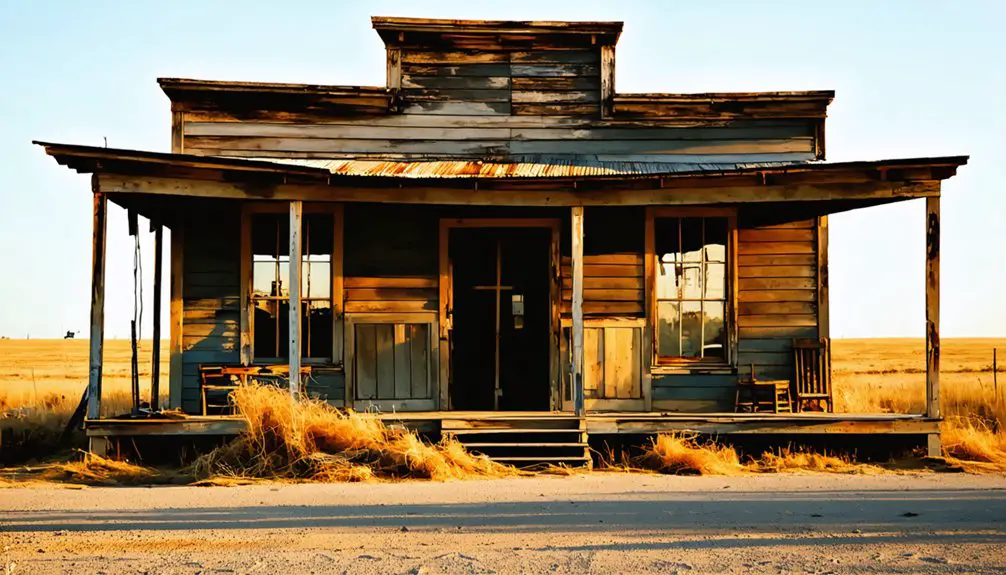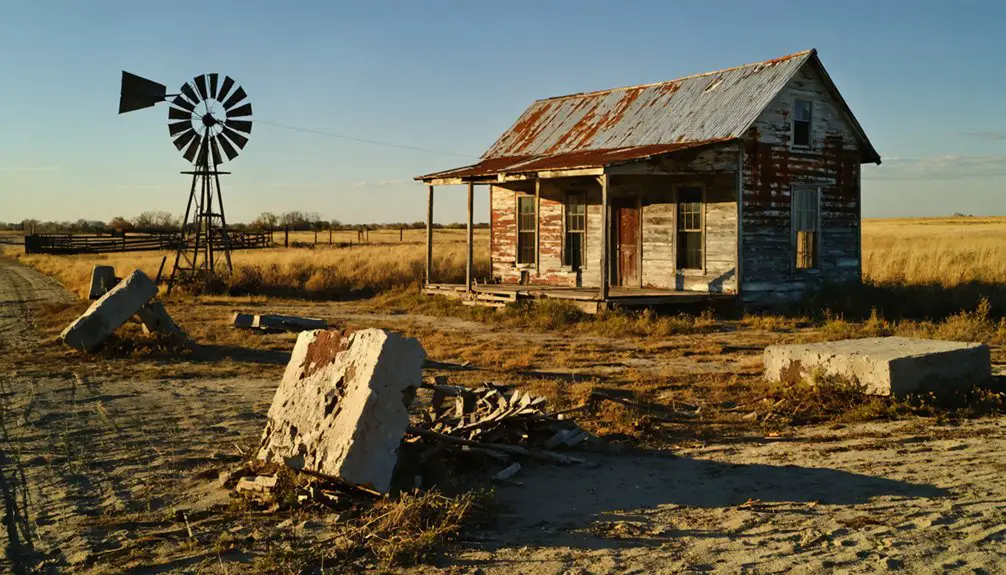You’ll find Eubanks among Oklahoma’s estimated 2,000 ghost towns, where it once thrived as a farming and ranching community during the frontier settlement period. The town developed essential infrastructure, including a post office and general store, while its economy centered on agriculture and cattle ranching. Like many Oklahoma boom towns, Eubanks declined as transportation networks shifted and younger residents left for urban opportunities. Today, deteriorating structures and cemetery grounds tell a deeper story of frontier life.
Key Takeaways
- Eubanks was established as a farming and ranching community in Oklahoma, becoming one of the state’s estimated 2,000 ghost towns.
- The town prospered through agriculture, cattle ranching, and local commerce before experiencing economic decline and population exodus.
- Essential infrastructure included a post office, general store, schools, and churches during its peak years of community life.
- Young residents gradually left for urban areas as job opportunities vanished and transportation networks bypassed the town.
- Today, only deteriorating structures, building foundations, and cemetery grounds remain as evidence of the former community.
Origins and Early Settlement
While Oklahoma boasts an estimated 2,000 ghost towns, Eubanks emerged as one of many settlements that dotted the state’s landscape during its early development.
Like neighboring communities, the town’s establishment followed typical settlement patterns of the era, beginning as a modest farming and ranching community before experiencing significant changes. Similar to towns like Whizbang that emerged during the 1920s oil boom, Eubanks underwent its own unique transformation. You’ll find the town’s naming conventions aligned with common practices of the time – likely derived from early settlers or landowners who shaped the area’s identity.
The early community reflected the diverse heritage of Oklahoma’s frontier, with Native American families, particularly those of Osage descent, playing influential roles in its formation. Many early settlements were established near mining operations, particularly those focused on lead and zinc extraction.
The establishment of essential infrastructure, including a post office and general store, marked Eubanks’ evolution from a simple settlement to a recognized community.
Life During the Boom Years
Three distinct phases marked Eubanks’ boom years: rapid growth, peak prosperity, and eventual decline.
During the early phase, you’d find a bustling town filled with independent oilfield workers living in hastily built structures. Social gatherings centered around saloons and dance halls, where the mostly single, male population sought entertainment after long workdays. Like many others, this town was established during the oil boom discoveries that attracted thousands seeking prosperity.
The Great Depression hit particularly hard, forcing many residents to abandon their homes and businesses in search of opportunities elsewhere.
As oil companies established more permanent operations, they brought in stable workers with families, transforming Eubanks’ character.
You’d see new infrastructure spring up – schools, churches, and proper stores. Recreational activities became more family-oriented, though the town retained its energetic spirit.
Economic Activities and Industries
Despite its eventual ghost town status, Eubanks initially thrived on a diverse economic foundation built around agriculture and commerce.
You’d find cotton and corn fields stretching across the landscape, with cattle grazing nearby. Local farmers formed agricultural cooperatives to weather challenges like the devastating 1901 drought, while cotton gins and flour mills processed the region’s harvests. Similar to other Oklahoma towns, a gypsum mining operation briefly supplemented the local economy.
Though nearby areas experienced oil booms, Eubanks remained primarily focused on farming and related businesses. Similar to Bank of Burbank, buildings from this era became historically significant landmarks.
You could visit the town’s livery stables, blacksmith shops, and general stores that supported the agricultural community. Transportation networks, including regional railroads and bridges, connected Eubanks’ products to broader markets.
While some communities transformed into boomtowns through oil or mining, Eubanks maintained its agricultural identity until its eventual decline.
Community Infrastructure
You’ll find Eubanks followed the typical pattern of Oklahoma boom towns, with essential services like a post office and general store establishing the community’s early infrastructure.
The town’s civic buildings, while modest in scale, served the daily needs of residents through the peak years as gathering places and service centers. Like many ghost towns that became testaments to economic aspirations, Eubanks represented both opportunity and uncertainty for early settlers.
When the local economy faltered, these public facilities gradually closed their doors, leaving behind only scattered remnants of what was once a functioning municipal framework.
Public Services Timeline
From its earliest days as a fledgling settlement, Eubanks established a foundation of crucial public services that would shape its brief existence. By 1907, you’d find a fully operational post office serving as the town’s primary communication infrastructure, connecting residents to the outside world through critical mail services.
Like many Oklahoma ghost towns of that era, Eubanks’ public services evolved around the needs of its settlers and travelers. The post office’s establishment marked a significant milestone in the town’s development, though it would later follow the familiar pattern of decline seen across similar settlements. Economic hardships and environmental challenges like severe drought periods contributed significantly to the town’s struggles. Eventually, the town became a neglected site, with only piles of rubble and a few deteriorating structures remaining.
When populations dwindled, these services became increasingly difficult to maintain. The closure of such crucial public services often signaled the beginning of the end for towns like Eubanks, reflecting the broader pattern of community dissolution.
Civic Buildings Overview
The skeletal remains of Eubanks’ civic buildings tell a stark story of the town’s rise and decline.
You’ll find the town’s civic architecture reflected in its abandoned school, where books and furniture still rest undisturbed, and a simple brick jail that once maintained order in this rural community.
The church, with its weathered facade, stands as one of the last preserved structures, proof of its community significance as both a spiritual center and meeting place.
These buildings showcased utilitarian designs typical of Oklahoma ghost towns, constructed with local materials and positioned strategically near transportation routes.
While time and nature have taken their toll through collapsed roofs and structural damage, these silent sentinels remain as evidence of Eubanks’ once-thriving public life and the gradual exodus of its people.
Like many towns affected during the era, Eubanks saw its decline accelerate when rail service ended in the 1940s.
Notable People and Stories

While many early Oklahoma towns faded into obscurity, Eubanks’ notable residents left an indelible mark on local history between 1907 and 1924.
You’ll find stories of prominent families who operated mercantile stores, post offices, and schools, serving as pillars of the community during its peak years. Their descendants continue to preserve the town’s legacy through oral histories and cemetery maintenance.
Local legends paint a fascinating picture of life in Eubanks, from tales of sudden departures to unexplained phenomena around abandoned buildings.
Notable families weathered harsh winters and economic hardships, often working in nearby coal mines or on the railroad. Their stories intertwine with broader regional events, including interactions with neighboring Native American communities and the challenges of early statehood.
Factors Leading to Decline
Like many Oklahoma ghost towns, Eubanks’ decline stemmed from the gradual erosion of its economic foundations as local commercial activities dried up.
You’d have seen families moving away to larger cities as job opportunities vanished and basic services became harder to maintain.
The town’s fate was sealed by the familiar pattern of younger residents leaving for urban areas, while the remaining population aged and dwindled without replacement.
Economic Activity Fades
During Eubanks’ gradual decline in the early-to-mid 20th century, several interconnected factors sealed the town’s economic fate. The closure of local mines and subsequent railroad service reductions dealt devastating blows to the community’s economic resilience strategies.
You’d have seen businesses shuttering one by one as the population dwindled, with community revitalization efforts hampered by the lack of diversification in the local economy.
- The loss of extractive industries left workers without alternative employment options
- Railroad service cuts isolated the town from essential trade connections
- Larger regional centers drew away resources and commercial activity
- Deteriorating infrastructure and closing amenities accelerated the exodus
As neighboring towns developed more diverse economies, Eubanks couldn’t compete, and its remaining commercial enterprises became unsustainable.
The town’s dependency on a single industry ultimately proved fatal to its survival.
Population Migration Patterns
Because shifting transportation networks reshaped Oklahoma’s economic landscape, Eubanks experienced a dramatic population exodus throughout the mid-20th century. As new highways bypassed the town, you’d have seen entire families packing up their belongings, seeking opportunities in larger urban centers.
The migration trends followed a familiar pattern you’ll recognize from other Oklahoma ghost towns. Young people left first, drawn to cities for education and modern jobs. Their parents often followed as agricultural consolidation reduced the need for small family farms.
These demographic shifts hit Eubanks particularly hard – without a diverse economic base, the town couldn’t retain its residents. When schools and local businesses started closing, you couldn’t blame the remaining families for relocating to places with better services and prospects for their children.
Physical Remnants Today

As time steadily erodes what remains of Eubanks, Oklahoma, you’ll find little more than deteriorating structures and scattered remnants marking this once-active settlement.
Natural reclamation has taken hold, with prairie grasses and woodland gradually consuming what’s left of the town’s physical footprint. You might spot foundations of old buildings, crumbling chimneys, or the faint outlines of former roads cutting through the landscape.
- Original church and schoolhouse shells may still stand as silent sentinels to the past
- Stone walls and building foundations outline where bustling streets once existed
- Old rail line traces and water infrastructure hint at the town’s former vibrancy
- Cemetery grounds and fence posts serve as lasting markers of community life
While most structures have succumbed to decades of exposure, these remaining features tell the story of early Oklahoma settlement life.
Historical Legacy and Preservation
Beyond the physical traces that dot the landscape, Eubanks’ historical legacy lives on through meticulous documentation and local preservation efforts.
You’ll find its story woven into Oklahoma’s broader narrative of frontier expansion, economic booms, and the challenges faced by early 20th-century settlers.
The town’s historical significance extends beyond its brief existence from 1907 to 1924, offering valuable insights into regional development patterns and socioeconomic shifts.
While preservation challenges include limited surviving structures and documentation, dedicated historians rely on oral histories and community memories to piece together Eubanks’ past.
Through historical markers and educational initiatives, you’re able to connect with this vanished community’s heritage, understanding how it fits into Oklahoma’s evolution from territory to statehood and its subsequent rural development.
Frequently Asked Questions
Are There Any Documented Paranormal Activities or Ghost Sightings in Eubanks?
You won’t find documented ghost encounters or haunted locations here – no reliable sources, investigations, or historical records mention paranormal activity in this area, despite Oklahoma’s rich tradition of ghost town hauntings.
What Was the Peak Population of Eubanks During Its Most Prosperous Years?
You won’t find exact numbers for Eubanks’ peak population in historical records, though based on similar Oklahoma ghost towns and regional patterns, it likely reached several hundred to low thousands during its heyday.
Can Visitors Legally Explore the Former Town Site of Eubanks Today?
You can’t legally explore without confirming property ownership and obtaining permission first. Town regulations and legal access requirements protect private land rights, so you’ll need landowner approval before visiting.
Were There Any Major Natural Disasters That Contributed to Eubanks’ Abandonment?
You won’t find clear evidence of natural calamities causing Eubanks’ abandonment. While environmental factors may have played a role, regional research suggests economic decline was more significant than any disasters.
Did Any Famous Outlaws or Historical Figures Ever Pass Through Eubanks?
You’d love a wild tale of outlaw encounters, but historical records don’t support any famous figures passing through. There’s no documented evidence of notable visitors during the town’s brief existence.
References
- https://nondoc.com/2022/01/04/whizbang-oklahoma-ghost-town/
- https://www.youtube.com/watch?v=5d-wHDTIbb0
- https://okcfox.com/news/local/oklahomas-secret-past-ghost-towns-of-oklahoma
- https://dharmaanchor.com/2014/09/25/ghost-towns-foss-ok/
- https://kids.kiddle.co/List_of_ghost_towns_in_Oklahoma
- https://en.wikipedia.org/wiki/List_of_ghost_towns_in_Oklahoma
- https://www.youtube.com/watch?v=nX1joQB_tf4
- https://www.okhistory.org/publications/enc/entry?entry=GH002
- https://okmag.com/blog/a-ghostly-site/
- https://www.okhistory.org/publications/enc/entry?entry=BU007



